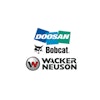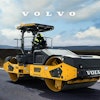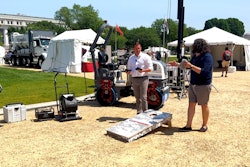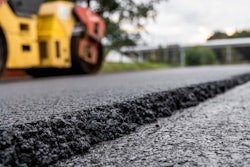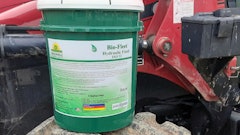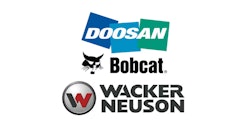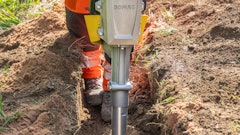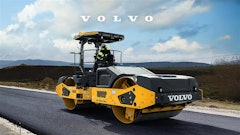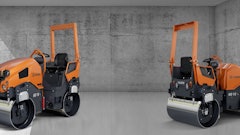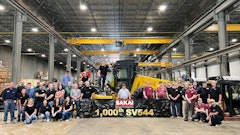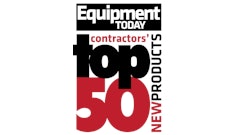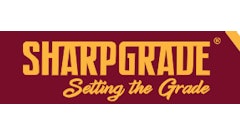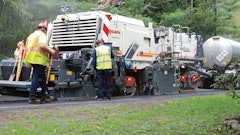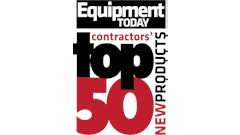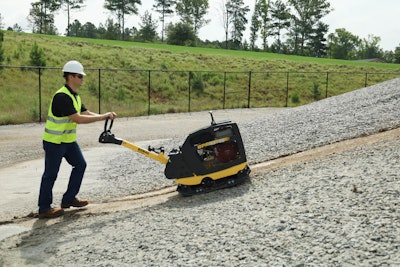
As the asphalt and pavement maintenance industry continues to utilize more and more zero-emission products, Wacker Neuson has recently responded by introducing a wide array of single-direction, battery-powered plate compactors.
Known as the APS series, the compactors are available in various plate widths, ranging from 13.8 to 19.7 inches. Offering the same performance capabilities as typical gasoline-powered models, one of the series’ plate compactors was released this year: the APU3050e. Providing users continuous forward and reverse compaction, the plate compactor utilizes an easy-to-use, interchangeable lithium-ion battery system (similar to the other APS plate compactors that have previously been released), while also offering operators quiet, zero-emission operation capacities.
In the meantime, the manufacturer has released newer models of its gasoline, single-direction plate compactors, too: the BPS series. Each of the series’ models have enhanced base plate designs, which allow operators to effortlessly handle them on soil, as well as fresh asphalt. Providing a centrifugal force that ranges from 2,248 to 4,496 pounds, along with an option to utilize a Briggs and Stratton or a Honda engine, the BPS series also has base plates that are available in 13.8-inch, 15.5-inch and 19.7-inch widths.
“Every model’s base plate has angular side edges too, leading to smooth, clean asphalt finishes along curbs and obstructions,” said Luke Sevcik, product application and training specialist, Wacker Neuson. “All models come with—or without—a large-capacity water tank for asphalt applications as well. The water system includes a large rotary knob that regulates water flow, while each model’s sprinkling system disperses water across the entire plate, ensuring asphalt doesn’t stick to it.”
Aside from being environmentally friendly, the plate compactors can also be utilized near curbs, as well as in tight areas. In addition, they require minimal maintenance, enabling them to have long lifespans.
“For example, each battery-powered plate compactor is essentially maintenance-free, due to its direct drive, which doesn’t have any V-belts, while offering lubricated bearings that are built to last throughout its lifespan too,” Sevcik added. “Meanwhile, the gasoline-powered plate compactors provide operators a rugged V-belt, along with bearings that have lifetime lubrication, leading to a significant reduction in maintenance.”
Compactors Enhance Operators’ Productivity
Recently, Volvo Construction Equipment began to accept reservations for its DD25 Electric asphalt compactor, its latest compactor offering. A zero-exhaust solution, the compactor can be utilized for small-scale compaction projects like driveways, parking lots and street repairs, due to its compactness. Featuring 32 hp (24 kW) of available power—30% more than its previously released, conventional counterpart—the DD25 is also more responsive than the manufacturer’s other compactors, with regards to its speed and vibrations.
As a result of its components’ sizes, the compactor, which is Volvo Construction Equipment’s first-ever electric machine for the road segment, performs better on grade, as well as at high elevations, when compared to diesel machines that lose power whenever altitude increases.
“While working in an urban or noise- and fume-sensitive area, the DD25 is an ideal solution, as it provides a cleaner work environment for operators, site teams and passers-by,” said Mark Eckert, product manager, Compactors, Compact Assist, Volvo Construction Equipment. “Whenever operators travel or operate with the drums off, the DD25 is very quiet, too.”
Rated for a temperature range of 14℉ to 104℉, the DD25 should be stored inside during the wintertime to enhance its battery performance (which isn’t affected when it’s used in this temperature range) whenever its utilized on cold days. Unlike the DD128C, a diesel, vibratory compactor that was also recently released and can be used in various temperatures, the DD25 doesn’t require as much time to warm up, prior to being utilized, as a compactor with a diesel engine does.
“The DD128C offers operators the asphalt and pavement maintenance industry’s highest frequency though: 4,800 vpm,” Eckert noted. “And its front drum is 79 inches wide with chamfer and radii drum edges, while its rear, 55-inch drum has auto-reversing eccentrics that ensure eccentric rotation in whichever direction it’s traveling, leading to smoothness.”
Of equal importance, the DD128C is also equipped with an automatic drum wetting system, which provides speed-dependent water flow, in order to reduce their water usage, as all coverage is uniform. Additionally, it has an eight amplitude eccentric system—the widest range of amplitudes (0.0003 to 0.03 inches) on the market—leading to high versatility, whether operators need to conduct ultra-thin or deep lifts.
“Due to our patented technology that can detect amplitude settings, the compactor’s vibration frequency is automatically adjusted to the highest vpm available, regarding its amplitude setting,” Eckert added. “Consequently, operators can achieve high rolling speeds and productivity—without any compromise.”
Plate Compactors are Durable and Dependable
With regards to its compaction equipment, Sakai America, Inc. hasn’t released any new light compaction equipment this year, as it has only updated its offerings’ colors. Striving for simplicity and focused on maintaining its reputation for dependability and durability, Sakai America, Inc. is also determined to continue to provide small project contractors a variety of benefits.
“We want to keep their maintenance costs down, ensure their uptime is as high as possible and offer machines they can use for years to come,” said Daniel Margrave, product training and marketing manager, Sakai America, Inc. “Our PC600 and PC800 plate compactors help small project contractors achieve these goals, among others.”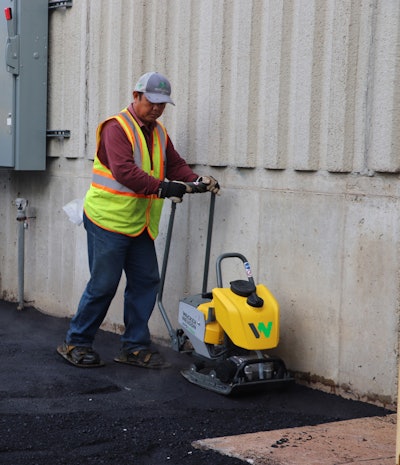 Wacker Neuson's APS series of single-direction, battery-powered plate compactors are available in various plate widths, ranging from 13.8 to 19.7 inches.
Wacker Neuson's APS series of single-direction, battery-powered plate compactors are available in various plate widths, ranging from 13.8 to 19.7 inches.
Very lightweight, relative to force, each plate compactor has abrasion-resistant steel plates, a quick-release water tank, shock isolation and a water spray system. Aside from their sizes—as the PC600 has an operating weight of 159 pounds, while the PC800 has an operating weight of 225 pounds—the plate compactors have one other key difference: the PC600 has a foldable handle, while the PC800 has a reversible handle.
“Powered by Honda GX120 engines that have 2-year warranties, the plate compactors can be utilized during any season, as well as in any climate,” Margrave added. “And, while using them whenever they’re comfortable with laying asphalt, operators will never have to be concerned about long-term downtime or excessive maintenance either.”
On the other hand, BOMAG Americas, Inc. offers operators two plate compactors: the BPR45/45 gas reversible plate compactor and the BPR60/65 gas reversible plate compactor. The BPR45/45 provides operators an 8.4 hp Honda GX270 engine, 10,116 pounds of centrifugal force, a working width of 21.7 inches and an operating weight of 750 pounds. In the meantime, the BPR60/65 offers operators an 11.7 hp Honda GX390 engine, along with 13,500 pounds of centrifugal force. Furthermore, it has a working width of 25.6 inches and an operating weight of 1,000 pounds.
“So many of our U.S.-based customers were moving from diesel reversible plate compactors to gas, leading us to deliver these two gas reversible plate compactors,” said David Dennison, territory sales manager, Midwest, BOMAG Americas, Inc. “Just like our diesel reversible plate compactors, the BPR45/45 and the BPR60/65 provide operators ease of service, high performance and reliability long term.”
He added, “Although both of the gas reversible plate compactors were designed for year-round operation, operators must remember that there are situations in which diesel reversible plate compactors may be more ideal options in colder temperatures. With this in mind, BOMAG Americas, Inc. has diesel reversible plate compactors that complement the gas reversible offerings and can perform in any climate, too.”
Compact Rollers for Various Applications
Aside from its APS and BPS plate compactor series, Wacker Neuson has also released a redesigned version of its RD12 ride-on roller. Designed for base preparation and asphalt finishes, the 1.2-ton tandem vibratory roller offers operators high visibility, along with curb clearance and service access. Ideal for residential and commercial construction, concerning asphalt and subbase soil compaction of driveways, nature trails, parking lots and secondary roads, the ride-on roller can be maneuvered in tight areas as well, due to its compact dimensions. Moreover, as a result of its design, the RD12 provides operators views of the entire drum edge as they approach obstacles and walls, leading to higher productivity.
“The RD12 benefits practically every contractor, whether they oversee small or large projects, in virtually any season, as it’s a multipurpose machine that can compact a variety of applications, including turf rolling,” Sevcik emphasized. “In hot locations, its tank should be drained daily though, in order to avoid bacterial growth and any potential clogging of its water distribution system. Conversely, it should also be drained and have an environmentally friendly, anti-freeze material run through it if operators decide not to use it during the winter.”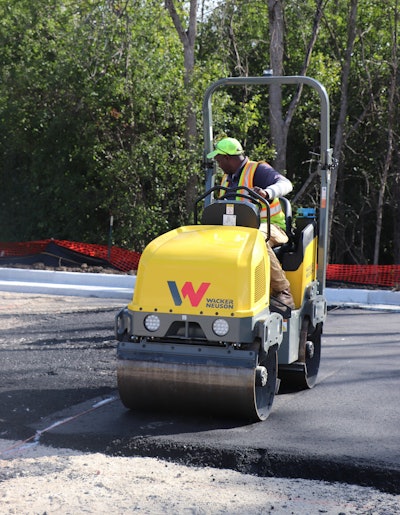 Designed for base preparation and asphalt finishes, Wacker Neuson's RD12, a 1.2-ton tandem vibratory roller, offers operators high visibility, along with curb clearance and service access.
Designed for base preparation and asphalt finishes, Wacker Neuson's RD12, a 1.2-ton tandem vibratory roller, offers operators high visibility, along with curb clearance and service access.
Meanwhile, Volvo Construction Equipment provides two combination rollers, the CR30 and CR35, which can be utilized for smaller projects like driveways, patchworks, pathways and road shoulders. Featuring a drum on its front side, along with high-frequency vibration, each of the rollers also has four rear-mounted pneumatic tires, which manipulate any compacted material, thereby improving surface texture, while decreasing water intrusion, too.
“The combination of these two compaction methods will help operators produce dense, high-quality mat surfaces,” Eckert said. “And, of equal importance, due to their smaller sizes, the CR30 and CR35 will reduce operators’ fuel consumption as well.”
Offering operators two other options as they conduct small asphalt projects, Sakai America, Inc. has developed the CR271 35.5-inch roller and the SW354 47-inch roller. Utilizing a 20.8 hp Honda GX630R engine, the CR271, which has an operating weight of 3,245 pounds and a vibration frequency of 4,000 vpm, doesn’t require any diesel after-treatment. Additionally, the roller—featuring 35.5-inch x 22-inch drums—doesn’t feature any complicated electronics either. Hence, operators can focus on other tasks, aside from electronic maintenance, resulting in higher productivity.
“The SW354 has a completely mechanical engine too—a Kubota D1703 T4 Final engine, which eliminates any necessity for a diesel particulate filter, diesel exhaust fluid or an engine control unit—ensuring that maintenance is as effortless as possible,” Margrave noted. “Therefore, operators will never have to worry about the downtime and costs that are associated with some rollers’ diesel engines.”
Although Sakai America hasn’t released any new asphalt rollers this year, it has launched Guardman variants throughout the last few months. Using millimeter radar or 3D-LiDAR (light detection and ranging), depending on whichever roller model operators prefer to utilize, Guardman detects and, most importantly, automatically brakes for equipment, objects and personnel that are behind asphalt rollers. As a result, product damage and injuries will decline.
“Of note, rollers equipped with Guardman are factory-built only, so retrofitting isn’t possible, as their hydraulic pumps, along with many other components, were re-engineered specifically for automatic braking,” Margrave added. “In turn, operators likely won’t have to repair or replace their rollers down the road, which will reduce their expenditures long term.”
Rollers for Several Purposes and Preferences
In recent months, BOMAG Americas, Inc. has released BW120 SLC combination rollers, which have a 24.8 hp Kubota engine, an operating weight of 5,070 pounds and a working width of 47.2 inches. Featuring a steel vibratory drum in its frontside, along with four pneumatic tires in its rear, each roller also utilizes the manufacturer’s BOMAG ECONOMIZER.
“By using the BOMAG ECONOMIZER, operators will have an ‘eye for compaction’, so to speak,” Dennison said. “After all, the onboard material stiffness indicator, located on rollers’ dashes, will signal, via a light, the various stages of material compaction stiffness, enabling operators to know exactly which stage they’re in, regarding each of their asphalt projects.”
Tim Kowalski, application support manager, Hamm, Wirtgen America, on the other hand, is preparing for new innovations, including several roller models that can be utilized efficiently on varying asphalt mixes and soil types. Two of its latest products are the HD10e and HD12e electric rollers, each of which are available in eight different models, including OT (oscillation, tires), VO (vibration, oscillation), VT (vibration, tires) and VV (vibration, vibration). In addition, it has released the HD+120i VIO-2 HF machine.
“It has taken our soil rollers’ VIO drum design and implemented it into an asphalt roller, which is capable of running dual vibration with both of its drums—in a high frequency of 4,020 vpm,” Kowalski explained. “Both drums can be used in oscillation or a combination of vibration and oscillation, too.”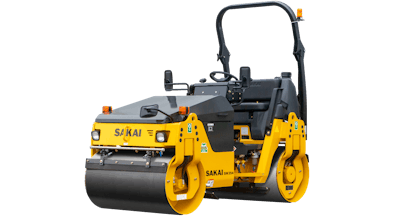 Sakai America, Inc.'s SW354 47-inch roller has a Kubota D1703 T4 Final engine, which eliminates any necessity for a diesel particulate filter, diesel exhaust fluid or an engine control unit.
Sakai America, Inc.'s SW354 47-inch roller has a Kubota D1703 T4 Final engine, which eliminates any necessity for a diesel particulate filter, diesel exhaust fluid or an engine control unit.
He added, “Furthermore, in automatic mode, operators can have the roller’s front drum in vibration and its rear drum in oscillation, while driving forward. Upon driving in reverse, the roller’s drums can switch, as its rear drum vibrates and its front drum uses oscillation, an advantage for operators that have many options, regarding compacting.”
Additionally, Wirtgen America has released its HP 100i, a nine-tire, articulated, pneumatic roller that’s based off of the manufacturer’s HD+ 70i frame. Offering a weight of 6 tons, which can be ballasted to 8 or 10 tons, if necessary, the roller has primarily been designed for chip seal purposes. Yet, it can also be utilized for smaller asphalt projects, due to its water and scrapper system.
Finally, the manufacturer has unveiled redesigned HC soil rollers as well. The HC 100i to 160i models feature John Deere engines that decrease noise levels by up to 20%, when compared to previously released versions, while the HC 180i to 250i models still have DEUTZ engines, along with 30% more cab space than past versions. At the same time, each HC 120i to 250i model has a seat that rotates to more than 70 degrees in one direction and 30 degrees in the other direction.
“Without question, the future of rollers is bright, as evidenced by our latest offerings,” Kowalski concluded. “Now is the time for operators to purchase their next roller, as they prepare to conduct their upcoming asphalt and pavement maintenance projects.”


